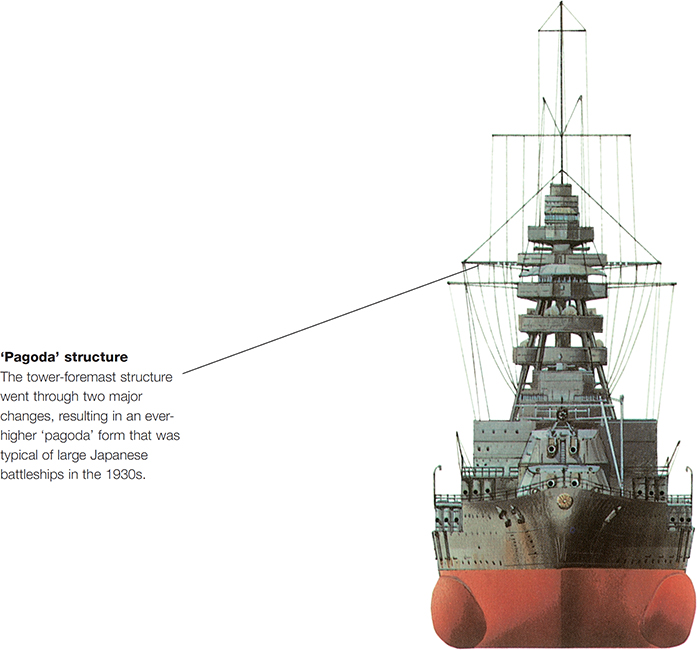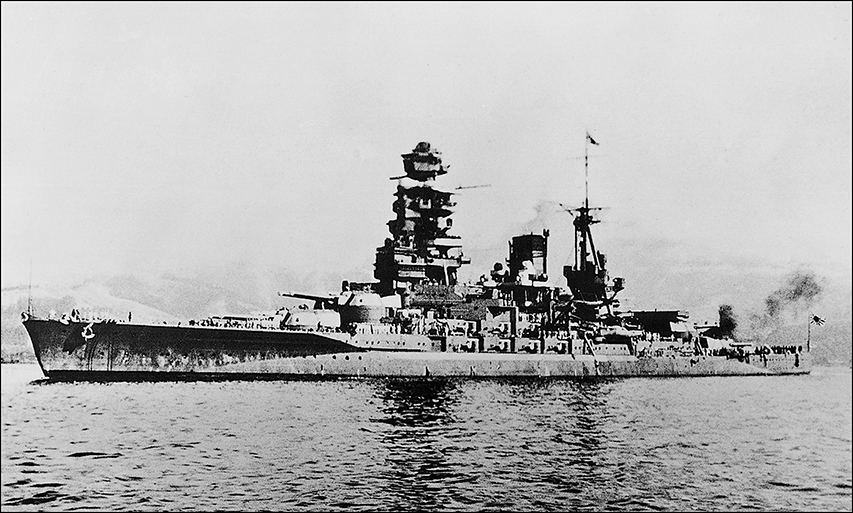 Nagato (1920)
Nagato (1920) Nagato (1920)
Nagato (1920)The war of 1905 with Russia had confirmed Japan as a major naval power. With the Nagato class it possessed two of the largest, most powerful and fastest battleships in the world.
Japanese naval chiefs studied the Battle of Jutland closely when the Nagato class was at the design stage, resulting in some delay while the lessons were absorbed by a team led by Captain Yuzuru Hiraga. Nagato was laid down on 28 August 1917 at the Kure Kaigun Kosho naval basin, launched on 9 November 1919 and completed on 25 November 1920.

The profile shows Nagato between 1925 and 1934; the face-on drawing shows the torpedo bulges applied in the 1934–36 refit, widening the beam from 28.9m (95ft) to 34.6m (113ft 6in). A triple bottom was also installed.
Nagato was the first ship to be armed with 406mm (16in) quick-firing guns. With L/45 barrel length and a weight of 100 tonnes (111 tons), they elevated (from 1936) to 43 degrees and had a range of 42,000m (45,930yd). The shells weighed 993kg (2189lb) and rate of fire was four rounds in three minutes. The armour plating was on the American principle of maximum fortification to the vital areas and little or nothing elsewhere, except that the lower deck was well protected with a thickness of 76–71mm (3–2.8in). Among the post-Jutland refinements of design was better anti-flash protection, with longitudinal anti-flash bulkheads between the guns, and in the lower levels of the turrets.

Dimensions |
Length 215.8m (708ft), Beam 29m (95ft 3in), Draught 9.1m (29ft 9in), Displacement 30,159 tonnes (33,245 tons); 34,927 tonnes (38,500 tons) full load |
Propulsion |
21 boilers (15 oil, 6 coal), 4 Gihon turbines developing 59,656kW (80,000hp), 4 screws |
Armament |
8 406mm (18in) guns, 20 140mm (5.5in) guns, 4 76mm (3in) AA guns, 8 533mm (21in) torpedo tubes |
Armour |
Belt 305–102mm (12–4in), Deck upper 44– 25mm (1.7–1in); lower 75–50mm (2.9–2.7in), Barbettes 300mm (11.8in), Turrets 356mm (14in), Conning tower forward 371mm (14.6in), aft 97mm (3.8in) |
Range |
10,550km (5700nm) at 16 knots |
Speed |
26.75 knots |
Complement |
1333 |
Nagato and its sister ship Mutsu (completed October 1921) outgunned any battleship in Western fleets. Even with the completion of USS Maryland in July 1921, carrying guns of the same calibre, the Japanese guns fired heavier shells and had a longer range. During 1921 negotiations for the Washington Naval Agreement were in progress to limit the size and number of capital ships, and construction stopped on six American battleships of the original South Dakota class. The Agreement allowed the almost-completed Mutsu to be commissioned. Of the two other Japanese battleships already laid down, one was stopped and the other eventually became the carrier Kaga.
Throughout its career Nagato carried its four main gun turrets, but in other respects underwent many changes. These began with a refit in 1924. In original form, the foremast was a multi-level tower mast built around six major struts and rising high above the navigation bridge. The central stem had a lift inside it, but the arrangement was disturbed by smoke and heat from the raised fore-funnel.

Nagato as it appeared in early 1944. An aircraft catapult was installed between the mainmast and ‘X’ turret.
A cowl fitted in 1922 was insufficient and in 1924 the funnel was altered in a bent-back formation to distance it from the tower. A second derrick was fixed to the aftermast to lift and lower floatplanes, and in 1925–26 a German Heinkel catapult was fitted to ‘B’ turret and became a prototype for Japanese designs.
A much more extensive modernisation was undertaken in 1934–36. Already in 1933 extra AA guns and a catapult abaft the aftermast had been fitted. Now the horizontal armour was reinforced to a maximum 207mm (8.15in), torpedo bulges 2.8m (9ft 2in) wide were applied, new boilers and engines were fitted along with a single funnel set well back from the tower and the hull was lengthened by 8.7m (28ft 6in) at the stern.
The torpedo tubes were taken out and new fire control systems were installed, along with further light AA guns. The main guns had their maximum angle of elevation raised from 30 to 43 degrees. An aircraft crane that could fold to lie on the deck was fitted on the port side of ‘X’ turret. The original inward-curving bow was replaced by a straight clipper bow (first tried out on Mutsu). Searchlight platforms were erected on each side of the funnel.

A deck plan of the 1924–34 layout. Note the prototype Heinkel catapult fitted on ‘B’ turret.
By 1936 the profile of Nagato was very different to that of 1933. Rangefinding equipment was installed, at first on ‘B’ and ‘X’ turrets and later above the bridge, along with radar aerials on both masts from 1944. Also in 1944 a high platform was built between the foremast and the funnel as a deck for further AA guns. By this time aerial attack was a deadly menace.
In World War II Nagato’s main actions were operations off Midway Island in June 1942, and the Leyte battles of 22–25 October 1944 when it sank the American escort carrier Gambier Bay and three destroyers. It returned to the Yokohama naval base and remained at anchor there, with the funnel cap and the after topmast taken down. On 18 July 1945 it was heavily damaged by aircraft strikes. After the war it was used as a target ship in the Bikini Atoll atom bomb tests. The second ‘Baker’ test on 25 July 1946 left it a wreck and it sank four days later.
Changing times
In the post-Dreadnought period from 1907 to 1921, the Japanese Imperial Navy acquired eight battleships and four battlecruisers. Official policy from 1910 was known as 8/8, meaning two capital ship squadrons of eight battleships and eight battlecruisers. Only one of these ships, the battlecruiser Kongo (1911), was built outside Japan (in Great Britain), as a deliberate move to acquire a prototype, though many Japanese ideas were incorporated in the design.
By 1919 it was realised that the pre-war ships were not fit for modern battle conditions, and Nagato and Mutsu were regarded as the first two of a new battleship squadron of eight ships. Though the USA and Japan had been allies in World War I, a trans-Pacific rivalry between these powers was a growing element in global politics. Japanese strategists were exploring the problems of a Pacific war, with its requirements of long range as well as heavy firepower, and battleships were an important element.